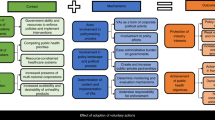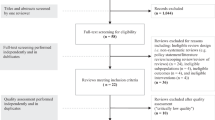Abstract
Background/Objectives:
Increasing political pressure on the food industry’s marketing activities stimulated the formation of the collective EU Pledge for responsible marketing of foods and beverages to children. The objective of the study is to evaluate the commitments made by companies in joining the pledge for the purpose of assessing its effectiveness in regulating signatory companies’ marketing activities.
Subjects/Methods:
Data on company commitments in relation to the EU Pledge were collected, analyzed and recalculated in order to enable comparison across companies and with general nutritional recommendations. Data on companies’ product portfolio and market orientation were collected from their most recent available annual reports. Data on the companies’ product profiles were generated via review of the companies’ main websites. Similar data were generated for a reference group of companies outside the EU Pledge.
Results:
Compared with a reference group of large food and beverage companies, EU Pledge signatory companies have a public image strongly based on products with appeal to children. The EU Pledge sets common standards for regulating signatory companies' marketing behaviour towards children. Further scrutiny of the companies' stated commitments revealed considerable variation in their actual content and in their de facto bindingness on the companies' marketing behaviour—for example, in the definition of target audience for advertising or in nutritional characteristics making products eligible for advertising to children.
Conclusions:
In order for voluntary self-regulation schemes such as the EU Pledge to be a credible alternative to public regulation of marketing behaviour, more transparency and stringency are needed.
This is a preview of subscription content, access via your institution
Access options
Subscribe to this journal
Receive 12 print issues and online access
$259.00 per year
only $21.58 per issue
Buy this article
- Purchase on Springer Link
- Instant access to full article PDF
Prices may be subject to local taxes which are calculated during checkout





Similar content being viewed by others
References
WHO Preventing Chronic Disease. A Vital Investment. World Health Organization: Geneva, 2005.
White paper on a strategy for Europe on Nutrition, Overweight and Obesity Related Health Issues (COM 2007279 Final). Commission of the European Communities, Brussels. 30 May 2007. http://eur-lex.europa.eu/LexUriServ/LexUriServ.do?uri=COM:2007:0279:FIN:EN:PDF (accessed on 25 September 2013).
World Health Organization Set of Recommendations on the Marketing of Foods and Non-alcoholic Beverages to Children 2010: World Health Organization http://www.who.int/dietphysicalactivity/publications/recsmarketing/en/index.html (accessed on 25 September 2013).
Cairns G, Angus K, Hastings G, Caraher M . Systematic reviews of the evidence on the nature, extent and effects of food marketing to children: a retrospective summary. Appetite 2013; 62: 209–215.
EU-platformEU Platform on Diet, Physical Activity and Health, 15 March 2005 http://ec.europa.eu/health/archive/ph_determinants/life_style/nutrition/platform/docs/platform_charter.pdf (accessed on 13 May 2014).
Hawkes C, Harris JL . An analysis of the content of food industry pledges to marketing to children. Public Health Nutr 2011; 14: 403–414.
Smith NC, Bhattacharya CB, Vogel D, Levine DI (eds). Global Challenges in Responsible Business. Cambridge University Press: Cambridge, 2010.
Gunningham N, Rees J . Industry self-regulation: an institutional perspective. Law Policy 1997; 19: 365–413.
Coleman W D . Global public policy, associative orders, and business interest associations. In: Streeck W (ed). Governing Interests. Business Associations Facing Internationalization. Routledge: London. pp 199–218, 2006.
Hoek J, King B . Food advertising and self-regulation: a view from the trenches. Aust N Z J Public Health 2008; 32: 261–265.
Reeve B . Private governance, public purpose? Assessing transparency and accountability in self-regulation of food advertising to children. J Bioeth Inq 2013; 10: 149–163.
Wilde P . Self-regulation and the response to concerns about food and beverage marketing to children in the United States. Nutr Rev 2009; 67: 155–166.
Ronit K, Jensen JD . Obesity and industry self-Regulation of food and beverage marketing: a literature review. Eur J Clin Nutr 2014; 68: 753–759.
Kent MP, Dubois L, Wanless A . Self-regulation by industry of food marketing is having little Impact during children’s preferred television. Int J Pediatr Obesity 2011; 6: 5–6.
King L, Hebden L, Grunseit A, Kelly B, Chapman K . Building the case for independent monitoring of food advertising on Australian television. Public Health Nutr 2013; 16: 2249–2254.
Roberts M, Pettigrew S, Chapman K, Miller C, Quester P . Compliance with children's television food advertising regulations in Australia. BMC Public Health 2012; 5: 846.
Romero-Fernandez M M, Royo-Bordonada MA, Rodrigues-Artalejo F . Compliance with self-regulation of television food and beverage advertising aimed at children in Spain. Public Health Nutr 2010; 13: 1013–1021.
EU—Pledge EU Pledge Nutrition White Paper. Brussels, 2012: http://www.eu-pledge.eu/sites/eu-pledge.eu/files/releases/EU_Pledge_Nutrition_White_Paper_Nov_2012.pdf accessed on 30 November 2014.
European Commission. Implementation Progress Report on the EU Strategy on Nutrition, Overweight and Obesity Related Health Conditions 2010: http://ec.europa.eu/health/nutrition_physical_activity/docs/implementation_report_en.pdf accessed on 21 May 2014.
IFBA International Food & Beverage AllianceA global commitment to action on the global strategy on diet, physical activity and health, letter to Dr. Margaret Chan, Director General of WHO, May 13, 2008 https://www.ifballiance.org/sites/default/files/IFBA%20-%20DG%20Chan%28May%202008%29.pdf accessed 21 May 2014.
Effertz T, Wilcke AC . ‘Do television food commercials target children in Germany?’. Public Health Nutr 2011; 15: 1466–1473.
World Health Organization. WHO opens public consultation on draft sugars guideline—note for media. March 5, 2014 http://www.who.int/mediacentre/news/notes/2014/consultation-sugar-guideline/en/ Accessed on 13 May 2014.
World Health Organization Interim Summary of Conclusions and Dietary Recommendations on Total Fat & Fatty Acids, From the Joint FAO/WHO Expert Consultation on Fats and Fatty Acids in Human Nutrition. 10–14 November 2008, WHO: Geneva http://www.who.int/nutrition/topics/FFA_summary_rec_conclusion.pdf Accessed on 13 May 2014.
Caraher M, Landon J, Dalmeny K . Television advertising and children: lessons from policy development. Public Health Nutr 2006; 9: 596–605.
Brinsden H, Lobstein T . Comparison of nutrient profiling schemes for restricting the marketing of food and drink to children. Pediatr Obes 2013; 8: 325–337.
Hebden L, King L, Kelly B, Chapman K, Innes-Hughes C, Gunatillaka N . Regulating the types of food and beverages marketed to Australian children: how useful are food industry commitments? Nutri Dietics 2010; 67: 258–266.
Roberto CA, Bragg MA, Livingston KA, Harris JL, Thompson JM, Seamans MJ et al. Choosing front-of-package food labeling nutritional criteria: how smart were ‘Smart Choices’? Public Health Nutr 2012; 15: 262–267.
Assmus G, Farley JU, Lehmann DR . How advertising affects sales: meta-analysis of econometric results. J Marketing Res 1984; 11: 65–74.
Sethuraman R, Tellis GJ, Briesch RA . How well does advertising work? Generalizations from meta-analysis of brand advertising elasticities. J Marketing Res 2011; 48: 457–471.
Author information
Authors and Affiliations
Corresponding author
Ethics declarations
Competing interests
The authors declare no conflict of interest.
Additional information
Supplementary Information accompanies this paper on European Journal of Clinical Nutrition website
Supplementary information
Rights and permissions
About this article
Cite this article
Jensen, J., Ronit, K. The EU pledge for responsible marketing of food and beverages to children: implementation in food companies. Eur J Clin Nutr 69, 896–901 (2015). https://doi.org/10.1038/ejcn.2015.52
Received:
Revised:
Accepted:
Published:
Issue Date:
DOI: https://doi.org/10.1038/ejcn.2015.52
This article is cited by
-
Understanding and use of food labeling systems among Whites and Latinos in the United States and among Mexicans: Results from the International Food Policy Study, 2017
International Journal of Behavioral Nutrition and Physical Activity (2019)
-
Nutritional quality of foods and non-alcoholic beverages advertised on Mexican television according to three nutrient profile models
BMC Public Health (2016)



